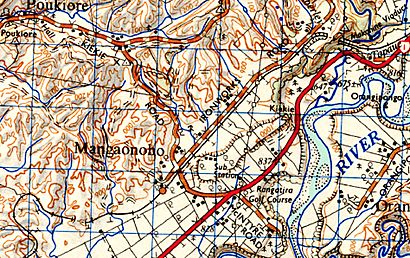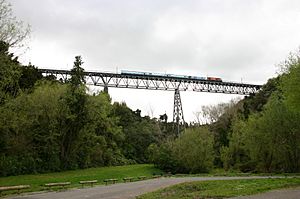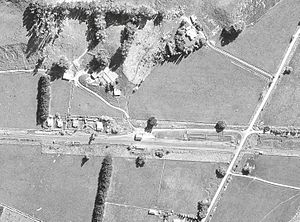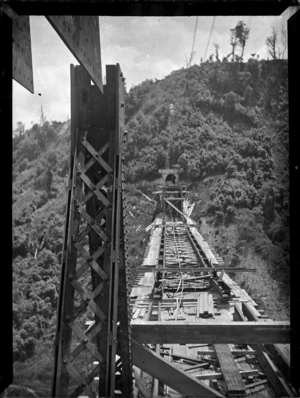Mangaonoho railway station facts for kids
Quick facts for kids
Mangaonoho railway station
|
|||||||||||
|---|---|---|---|---|---|---|---|---|---|---|---|

Mangaonoho station on 1979 map
|
|||||||||||
| Location | New Zealand | ||||||||||
| Coordinates | 39°52′45″S 175°39′47″E / 39.879220°S 175.663190°E | ||||||||||
| Elevation | 257 m (843 ft) | ||||||||||
| Line(s) | North Island Main Trunk | ||||||||||
| Distance | Wellington 216.04 km (134.24 mi) | ||||||||||
| History | |||||||||||
| Opened | 14 April 1893 | ||||||||||
| Closed | 31 January 1982 | ||||||||||
| Electrified | June 1988 | ||||||||||
| Services | |||||||||||
|
|||||||||||
Mangaonoho railway station was a busy train stop in New Zealand. It was part of the North Island Main Trunk railway line. For about ten years, from 1893 to 1902, Mangaonoho was a very important place. It was the northern end of the railway line's southern part. People even planned to build a refreshment room there!
Building the railway further north was tricky. Workers had to build huge bridges called viaducts. The first big one was Makōhine. To help build Makōhine, a special railway workshop was set up just north of Mangaonoho.
Unlike many other railway construction towns, Mangaonoho slowly became less important after the line was finished. By 1911, its population was only 167 people. The station closed in 1982. Today, only a single railway line runs through where the station used to be.
The New Zealand Ministry for Culture and Heritage says that Mangaonoho means "the stream of Noho."
Contents
Station History
The Mangaonoho station area started with a small cottage for railway workers and a side track in 1892. A sawmill was moved to the station in 1893.
The railway line was extended to Mangaonoho in 1893. Regular train services began on 1 May 1893. A contract to build the station was signed in March 1893. Work on the station building continued into 1895. A house for the stationmaster and a windmill for water were also finished in 1895.
The station had an engine shed for trains and a large shed for goods. There was also a loading area and yards for cattle and sheep. A crane was added in 1897 to help load heavy items. A post office opened at the station on 6 June 1894. The station used special signals to control train movements. It also had a long track where trains could wait for others to pass.
Mangaonoho became a main accounting station in April 1894. This happened after a telegraph line was built from Hunterville. The station had three staff members. In the year ending March 1895, they sold 5,752 train tickets.
By 1902, the station had six staff members. They sold 13,425 tickets that year. A huge amount of timber, about 1.7 million board feet, was sent by train from Mangaonoho.
The station's importance began to fade when the railway line opened all the way to Mangaweka in August 1902. Mangaonoho became a "flag station" where trains only stopped if someone waved a flag. It lost its stationmaster in November 1902. The Post Office closed in 1903, reopened in 1908, and finally closed for good in 1963.
Part of the goods shed was moved away in 1906. In 1911, two station cottages were also moved to other towns. The station building itself was approved for removal in 1971. The station officially closed to all train traffic in September 1986.
Railway Workshop
The Mangaonoho Public Works Department workshop opened in 1896. It was about 1.37 kilometers north of the station. This workshop was fully working by late 1898. Electricity lit up the tracks and workshop, allowing workers to work 16-hour days.
The workshop made all the steel parts for the huge Makōhine Viaduct. These parts were ready in 1900. Up to 300 people worked on building the viaduct. Sadly, two workers died in accidents.
In 1901, the workshop also started preparing steel for the Mangaweka Viaduct. Later, it made steel for the Taonui and Hapuawhenua viaducts, which opened in 1908.
Makōhine Tunnel
About 1.83 kilometers north of the workshop was the Makōhine tunnel. This tunnel was 198 yards long. It was finished in 1894 after 14 months of hard work. The tunnel allowed the railway tracks to reach the edge of the Makōhine gorge. This made it easier to get to the viaduct building site.
The tunnel was built by groups of workers who worked together. They did not have any accidents during construction. However, a mother and her four children died when a pile of dirt from the tunnel digging fell on them. In 1984, before the railway line was electrified, the tunnel was opened up to the sky. This means the top was removed, turning it into an open cutting.
| Makōhine viaduct | |
|---|---|

Overlander train crossing
the Makōhine Viaduct |
|
| Coordinates | 39°52′11″S 175°40′58″E / 39.869771°S 175.682708°E |
| Carries | Single track of the North Island Main Trunk |
| Crosses | Makōhine Stream |
| Owner | KiwiRail |
| Characteristics | |
| Design | Two steel trestle piers, two 75 metres (246 ft) steel Warren trusses and a central 53 metres (174 ft) truss. |
| Material | Steel |
| Total length | 228 metres (748 ft) |
| Height | 72 metres (236 ft) |
| Number of spans | 3 |
| History | |
| Engineering design by | Public Works Department |
| Constructed by | PWD |
| Construction begin | 1896 |
| Opened | 17 June 1902 |
| Designated: | 2 April 1985 |
| Reference #: | 32 |
Makōhine Viaduct
The Makōhine Viaduct is very close to where the tunnel used to be. It is the most southern of the five biggest viaducts on the North Island Main Trunk line. It crosses over the Makōhine Stream. This stream flows into the Rangitīkei River nearby. The stream has cut deep into the soft ground of the Wanganui Basin.
Even though the railway tracks reached the gorge in 1894, building the viaduct took a long time. The first offers to build it were too expensive. So, the Public Works Department used groups of workers to build it. There were more delays because of a steel strike in Britain, where the steel came from. Heavy rain also made the ground unstable, affecting the bridge's foundations.
The actual building of the piers (the tall supports) didn't start until 1900. This viaduct has longer sections between its supports than other viaducts. This design meant fewer piers were needed. The viaduct was officially opened on 17 June 1902.
The viaduct was made stronger around 1932. This allowed heavier trains to cross it safely. It was strengthened again in the early 1980s. This time, it was to prepare for the railway line to be electrified. Older wooden parts were replaced with steel, and new links were added to help the bridge handle the forces from trains.
Mangaonoho Railway Changes
The 1979 map shows that the railway line south of Mangaonoho mostly curved around the hills. In 1972, an old tunnel (Tunnel No. 19) was opened up to the sky. This part of the line was later changed.
In 1984, a new section of railway line was built. This new section straightened the line. It also bypassed an older tunnel (Tunnel No. 8) by creating a large cutting through the ground at a lower level. These changes made the railway line more modern and efficient.





